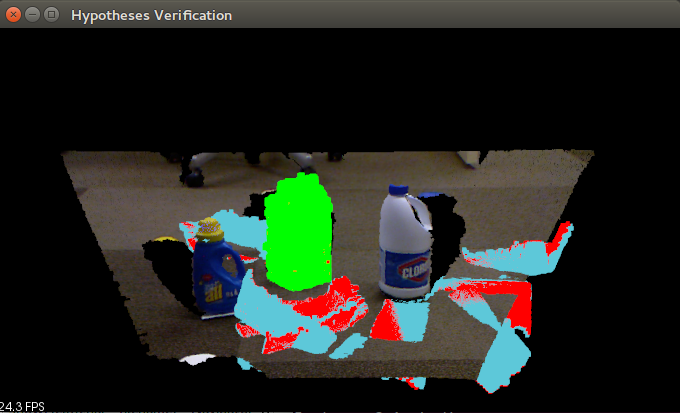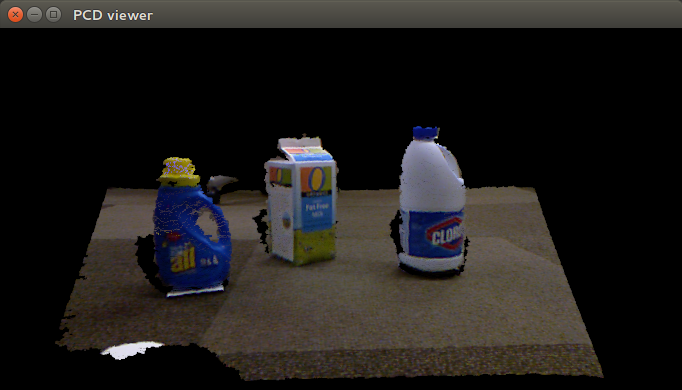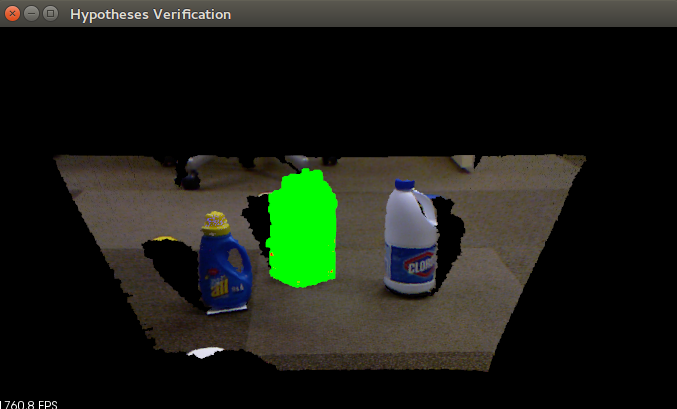3D物体识别的假设验证
这次目的在于解释如何做3D物体识别通过验证模型假设在聚类里面。在描述器匹配后,这次我们将运行某个相关组算法在PCL里面为了聚类点对点相关性的集合,决定假设物体在场景里面的实例。在这个假定里面,全局假设验证算法将被用来减少错误的数量。
代码:
在开始之前,你应该从Correspondence Grouping里面下载文件。
下面是代码
/* * Software License Agreement (BSD License) * * Point Cloud Library (PCL) - www.pointclouds.org * Copyright (c) 2014-, Open Perception, Inc. * * All rights reserved. * * Redistribution and use in source and binary forms, with or without * modification, are permitted provided that the following conditions * are met: * * * Redistributions of source code must retain the above copyright * notice, this list of conditions and the following disclaimer. * * Redistributions in binary form must reproduce the above * copyright notice, this list of conditions and the following * disclaimer in the documentation and/or other materials provided * with the distribution. * * Neither the name of the copyright holder(s) nor the names of its * contributors may be used to endorse or promote products derived * from this software without specific prior written permission. * * THIS SOFTWARE IS PROVIDED BY THE COPYRIGHT HOLDERS AND CONTRIBUTORS * "AS IS" AND ANY EXPRESS OR IMPLIED WARRANTIES, INCLUDING, BUT NOT * LIMITED TO, THE IMPLIED WARRANTIES OF MERCHANTABILITY AND FITNESS * FOR A PARTICULAR PURPOSE ARE DISCLAIMED. IN NO EVENT SHALL THE * COPYRIGHT OWNER OR CONTRIBUTORS BE LIABLE FOR ANY DIRECT, INDIRECT, * INCIDENTAL, SPECIAL, EXEMPLARY, OR CONSEQUENTIAL DAMAGES (INCLUDING, * BUT NOT LIMITED TO, PROCUREMENT OF SUBSTITUTE GOODS OR SERVICES; * LOSS OF USE, DATA, OR PROFITS; OR BUSINESS INTERRUPTION) HOWEVER * CAUSED AND ON ANY THEORY OF LIABILITY, WHETHER IN CONTRACT, STRICT * LIABILITY, OR TORT (INCLUDING NEGLIGENCE OR OTHERWISE) ARISING IN * ANY WAY OUT OF THE USE OF THIS SOFTWARE, EVEN IF ADVISED OF THE * POSSIBILITY OF SUCH DAMAGE. * */ #include <pcl/io/pcd_io.h> #include <pcl/point_cloud.h> #include <pcl/correspondence.h> #include <pcl/features/normal_3d_omp.h> #include <pcl/features/shot_omp.h> #include <pcl/features/board.h> #include <pcl/filters/uniform_sampling.h> #include <pcl/recognition/cg/hough_3d.h> #include <pcl/recognition/cg/geometric_consistency.h> #include <pcl/recognition/hv/hv_go.h> #include <pcl/registration/icp.h> #include <pcl/visualization/pcl_visualizer.h> #include <pcl/kdtree/kdtree_flann.h> #include <pcl/kdtree/impl/kdtree_flann.hpp> #include <pcl/common/transforms.h> #include <pcl/console/parse.h> typedef pcl::PointXYZRGBA PointType; typedef pcl::Normal NormalType; typedef pcl::ReferenceFrame RFType; typedef pcl::SHOT352 DescriptorType; struct CloudStyle { double r; double g; double b; double size; CloudStyle (double r, double g, double b, double size) : r (r), g (g), b (b), size (size) { } }; CloudStyle style_white (255.0, 255.0, 255.0, 4.0); CloudStyle style_red (255.0, 0.0, 0.0, 3.0); CloudStyle style_green (0.0, 255.0, 0.0, 5.0); CloudStyle style_cyan (93.0, 200.0, 217.0, 4.0); CloudStyle style_violet (255.0, 0.0, 255.0, 8.0); std::string model_filename_; std::string scene_filename_; //Algorithm params bool show_keypoints_ (false); bool use_hough_ (true); float model_ss_ (0.02f); float scene_ss_ (0.02f); float rf_rad_ (0.015f); float descr_rad_ (0.02f); float cg_size_ (0.01f); float cg_thresh_ (5.0f); int icp_max_iter_ (5); float icp_corr_distance_ (0.005f); float hv_clutter_reg_ (5.0f); float hv_inlier_th_ (0.005f); float hv_occlusion_th_ (0.01f); float hv_rad_clutter_ (0.03f); float hv_regularizer_ (3.0f); float hv_rad_normals_ (0.05); bool hv_detect_clutter_ (true); /** * Prints out Help message * @param filename Runnable App Name */ void showHelp (char *filename) { std::cout << std::endl; std::cout << "***************************************************************************" << std::endl; std::cout << "* *" << std::endl; std::cout << "* Global Hypothese Verification Tutorial - Usage Guide *" << std::endl; std::cout << "* *" << std::endl; std::cout << "***************************************************************************" << std::endl << std::endl; std::cout << "Usage: " << filename << " model_filename.pcd scene_filename.pcd [Options]" << std::endl << std::endl; std::cout << "Options:" << std::endl; std::cout << " -h: Show this help." << std::endl; std::cout << " -k: Show keypoints." << std::endl; std::cout << " --algorithm (Hough|GC): Clustering algorithm used (default Hough)." << std::endl; std::cout << " --model_ss val: Model uniform sampling radius (default " << model_ss_ << ")" << std::endl; std::cout << " --scene_ss val: Scene uniform sampling radius (default " << scene_ss_ << ")" << std::endl; std::cout << " --rf_rad val: Reference frame radius (default " << rf_rad_ << ")" << std::endl; std::cout << " --descr_rad val: Descriptor radius (default " << descr_rad_ << ")" << std::endl; std::cout << " --cg_size val: Cluster size (default " << cg_size_ << ")" << std::endl; std::cout << " --cg_thresh val: Clustering threshold (default " << cg_thresh_ << ")" << std::endl << std::endl; std::cout << " --icp_max_iter val: ICP max iterations number (default " << icp_max_iter_ << ")" << std::endl; std::cout << " --icp_corr_distance val: ICP correspondence distance (default " << icp_corr_distance_ << ")" << std::endl << std::endl; std::cout << " --hv_clutter_reg val: Clutter Regularizer (default " << hv_clutter_reg_ << ")" << std::endl; std::cout << " --hv_inlier_th val: Inlier threshold (default " << hv_inlier_th_ << ")" << std::endl; std::cout << " --hv_occlusion_th val: Occlusion threshold (default " << hv_occlusion_th_ << ")" << std::endl; std::cout << " --hv_rad_clutter val: Clutter radius (default " << hv_rad_clutter_ << ")" << std::endl; std::cout << " --hv_regularizer val: Regularizer value (default " << hv_regularizer_ << ")" << std::endl; std::cout << " --hv_rad_normals val: Normals radius (default " << hv_rad_normals_ << ")" << std::endl; std::cout << " --hv_detect_clutter val: TRUE if clutter detect enabled (default " << hv_detect_clutter_ << ")" << std::endl << std::endl; } /** * Parses Command Line Arguments (Argc,Argv) * @param argc * @param argv */ void parseCommandLine (int argc, char *argv[]) { //Show help if (pcl::console::find_switch (argc, argv, "-h")) { showHelp (argv[0]); exit (0); } //Model & scene filenames std::vector<int> filenames; filenames = pcl::console::parse_file_extension_argument (argc, argv, ".pcd"); if (filenames.size () != 2) { std::cout << "Filenames missing.\n"; showHelp (argv[0]); exit (-1); } model_filename_ = argv[filenames[0]]; scene_filename_ = argv[filenames[1]]; //Program behavior if (pcl::console::find_switch (argc, argv, "-k")) { show_keypoints_ = true; } std::string used_algorithm; if (pcl::console::parse_argument (argc, argv, "--algorithm", used_algorithm) != -1) { if (used_algorithm.compare ("Hough") == 0) { use_hough_ = true; } else if (used_algorithm.compare ("GC") == 0) { use_hough_ = false; } else { std::cout << "Wrong algorithm name.\n"; showHelp (argv[0]); exit (-1); } } //General parameters pcl::console::parse_argument (argc, argv, "--model_ss", model_ss_); pcl::console::parse_argument (argc, argv, "--scene_ss", scene_ss_); pcl::console::parse_argument (argc, argv, "--rf_rad", rf_rad_); pcl::console::parse_argument (argc, argv, "--descr_rad", descr_rad_); pcl::console::parse_argument (argc, argv, "--cg_size", cg_size_); pcl::console::parse_argument (argc, argv, "--cg_thresh", cg_thresh_); pcl::console::parse_argument (argc, argv, "--icp_max_iter", icp_max_iter_); pcl::console::parse_argument (argc, argv, "--icp_corr_distance", icp_corr_distance_); pcl::console::parse_argument (argc, argv, "--hv_clutter_reg", hv_clutter_reg_); pcl::console::parse_argument (argc, argv, "--hv_inlier_th", hv_inlier_th_); pcl::console::parse_argument (argc, argv, "--hv_occlusion_th", hv_occlusion_th_); pcl::console::parse_argument (argc, argv, "--hv_rad_clutter", hv_rad_clutter_); pcl::console::parse_argument (argc, argv, "--hv_regularizer", hv_regularizer_); pcl::console::parse_argument (argc, argv, "--hv_rad_normals", hv_rad_normals_); pcl::console::parse_argument (argc, argv, "--hv_detect_clutter", hv_detect_clutter_); } int main (int argc, char *argv[]) { parseCommandLine (argc, argv); pcl::PointCloud<PointType>::Ptr model (new pcl::PointCloud<PointType> ()); pcl::PointCloud<PointType>::Ptr model_keypoints (new pcl::PointCloud<PointType> ()); pcl::PointCloud<PointType>::Ptr scene (new pcl::PointCloud<PointType> ()); pcl::PointCloud<PointType>::Ptr scene_keypoints (new pcl::PointCloud<PointType> ()); pcl::PointCloud<NormalType>::Ptr model_normals (new pcl::PointCloud<NormalType> ()); pcl::PointCloud<NormalType>::Ptr scene_normals (new pcl::PointCloud<NormalType> ()); pcl::PointCloud<DescriptorType>::Ptr model_descriptors (new pcl::PointCloud<DescriptorType> ()); pcl::PointCloud<DescriptorType>::Ptr scene_descriptors (new pcl::PointCloud<DescriptorType> ()); /** * Load Clouds */ if (pcl::io::loadPCDFile (model_filename_, *model) < 0) { std::cout << "Error loading model cloud." << std::endl; showHelp (argv[0]); return (-1); } if (pcl::io::loadPCDFile (scene_filename_, *scene) < 0) { std::cout << "Error loading scene cloud." << std::endl; showHelp (argv[0]); return (-1); } /** * Compute Normals */ pcl::NormalEstimationOMP<PointType, NormalType> norm_est; norm_est.setKSearch (10); norm_est.setInputCloud (model); norm_est.compute (*model_normals); norm_est.setInputCloud (scene); norm_est.compute (*scene_normals); /** * Downsample Clouds to Extract keypoints */ pcl::UniformSampling<PointType> uniform_sampling; uniform_sampling.setInputCloud (model); uniform_sampling.setRadiusSearch (model_ss_); uniform_sampling.filter (*model_keypoints); std::cout << "Model total points: " << model->size () << "; Selected Keypoints: " << model_keypoints->size () << std::endl; uniform_sampling.setInputCloud (scene); uniform_sampling.setRadiusSearch (scene_ss_); uniform_sampling.filter (*scene_keypoints); std::cout << "Scene total points: " << scene->size () << "; Selected Keypoints: " << scene_keypoints->size () << std::endl; /** * Compute Descriptor for keypoints */ pcl::SHOTEstimationOMP<PointType, NormalType, DescriptorType> descr_est; descr_est.setRadiusSearch (descr_rad_); descr_est.setInputCloud (model_keypoints); descr_est.setInputNormals (model_normals); descr_est.setSearchSurface (model); descr_est.compute (*model_descriptors); descr_est.setInputCloud (scene_keypoints); descr_est.setInputNormals (scene_normals); descr_est.setSearchSurface (scene); descr_est.compute (*scene_descriptors); /** * Find Model-Scene Correspondences with KdTree */ pcl::CorrespondencesPtr model_scene_corrs (new pcl::Correspondences ()); pcl::KdTreeFLANN<DescriptorType> match_search; match_search.setInputCloud (model_descriptors); std::vector<int> model_good_keypoints_indices; std::vector<int> scene_good_keypoints_indices; for (size_t i = 0; i < scene_descriptors->size (); ++i) { std::vector<int> neigh_indices (1); std::vector<float> neigh_sqr_dists (1); if (!pcl_isfinite (scene_descriptors->at (i).descriptor[0])) //skipping NaNs { continue; } int found_neighs = match_search.nearestKSearch (scene_descriptors->at (i), 1, neigh_indices, neigh_sqr_dists); if (found_neighs == 1 && neigh_sqr_dists[0] < 0.25f) { pcl::Correspondence corr (neigh_indices[0], static_cast<int> (i), neigh_sqr_dists[0]); model_scene_corrs->push_back (corr); model_good_keypoints_indices.push_back (corr.index_query); scene_good_keypoints_indices.push_back (corr.index_match); } } pcl::PointCloud<PointType>::Ptr model_good_kp (new pcl::PointCloud<PointType> ()); pcl::PointCloud<PointType>::Ptr scene_good_kp (new pcl::PointCloud<PointType> ()); pcl::copyPointCloud (*model_keypoints, model_good_keypoints_indices, *model_good_kp); pcl::copyPointCloud (*scene_keypoints, scene_good_keypoints_indices, *scene_good_kp); std::cout << "Correspondences found: " << model_scene_corrs->size () << std::endl; /** * Clustering */ std::vector<Eigen::Matrix4f, Eigen::aligned_allocator<Eigen::Matrix4f> > rototranslations; std::vector < pcl::Correspondences > clustered_corrs; if (use_hough_) { pcl::PointCloud<RFType>::Ptr model_rf (new pcl::PointCloud<RFType> ()); pcl::PointCloud<RFType>::Ptr scene_rf (new pcl::PointCloud<RFType> ()); pcl::BOARDLocalReferenceFrameEstimation<PointType, NormalType, RFType> rf_est; rf_est.setFindHoles (true); rf_est.setRadiusSearch (rf_rad_); rf_est.setInputCloud (model_keypoints); rf_est.setInputNormals (model_normals); rf_est.setSearchSurface (model); rf_est.compute (*model_rf); rf_est.setInputCloud (scene_keypoints); rf_est.setInputNormals (scene_normals); rf_est.setSearchSurface (scene); rf_est.compute (*scene_rf); // Clustering pcl::Hough3DGrouping<PointType, PointType, RFType, RFType> clusterer; clusterer.setHoughBinSize (cg_size_); clusterer.setHoughThreshold (cg_thresh_); clusterer.setUseInterpolation (true); clusterer.setUseDistanceWeight (false); clusterer.setInputCloud (model_keypoints); clusterer.setInputRf (model_rf); clusterer.setSceneCloud (scene_keypoints); clusterer.setSceneRf (scene_rf); clusterer.setModelSceneCorrespondences (model_scene_corrs); clusterer.recognize (rototranslations, clustered_corrs); } else { pcl::GeometricConsistencyGrouping<PointType, PointType> gc_clusterer; gc_clusterer.setGCSize (cg_size_); gc_clusterer.setGCThreshold (cg_thresh_); gc_clusterer.setInputCloud (model_keypoints); gc_clusterer.setSceneCloud (scene_keypoints); gc_clusterer.setModelSceneCorrespondences (model_scene_corrs); gc_clusterer.recognize (rototranslations, clustered_corrs); } /** * Stop if no instances */ if (rototranslations.size () <= 0) { cout << "*** No instances found! ***" << endl; return (0); } else { cout << "Recognized Instances: " << rototranslations.size () << endl << endl; } /** * Generates clouds for each instances found */ std::vector<pcl::PointCloud<PointType>::ConstPtr> instances; for (size_t i = 0; i < rototranslations.size (); ++i) { pcl::PointCloud<PointType>::Ptr rotated_model (new pcl::PointCloud<PointType> ()); pcl::transformPointCloud (*model, *rotated_model, rototranslations[i]); instances.push_back (rotated_model); } /** * ICP */ std::vector<pcl::PointCloud<PointType>::ConstPtr> registered_instances; if (true) { cout << "--- ICP ---------" << endl; for (size_t i = 0; i < rototranslations.size (); ++i) { pcl::IterativeClosestPoint<PointType, PointType> icp; icp.setMaximumIterations (icp_max_iter_); icp.setMaxCorrespondenceDistance (icp_corr_distance_); icp.setInputTarget (scene); icp.setInputSource (instances[i]); pcl::PointCloud<PointType>::Ptr registered (new pcl::PointCloud<PointType>); icp.align (*registered); registered_instances.push_back (registered); cout << "Instance " << i << " "; if (icp.hasConverged ()) { cout << "Aligned!" << endl; } else { cout << "Not Aligned!" << endl; } } cout << "-----------------" << endl << endl; } /** * Hypothesis Verification */ cout << "--- Hypotheses Verification ---" << endl; std::vector<bool> hypotheses_mask; // Mask Vector to identify positive hypotheses pcl::GlobalHypothesesVerification<PointType, PointType> GoHv; GoHv.setSceneCloud (scene); // Scene Cloud GoHv.addModels (registered_instances, true); //Models to verify GoHv.setInlierThreshold (hv_inlier_th_); GoHv.setOcclusionThreshold (hv_occlusion_th_); GoHv.setRegularizer (hv_regularizer_); GoHv.setRadiusClutter (hv_rad_clutter_); GoHv.setClutterRegularizer (hv_clutter_reg_); GoHv.setDetectClutter (hv_detect_clutter_); GoHv.setRadiusNormals (hv_rad_normals_); GoHv.verify (); GoHv.getMask (hypotheses_mask); // i-element TRUE if hvModels[i] verifies hypotheses for (int i = 0; i < hypotheses_mask.size (); i++) { if (hypotheses_mask[i]) { cout << "Instance " << i << " is GOOD! <---" << endl; } else { cout << "Instance " << i << " is bad!" << endl; } } cout << "-------------------------------" << endl; /** * Visualization */ pcl::visualization::PCLVisualizer viewer ("Hypotheses Verification"); viewer.addPointCloud (scene, "scene_cloud"); pcl::PointCloud<PointType>::Ptr off_scene_model (new pcl::PointCloud<PointType> ()); pcl::PointCloud<PointType>::Ptr off_scene_model_keypoints (new pcl::PointCloud<PointType> ()); pcl::PointCloud<PointType>::Ptr off_model_good_kp (new pcl::PointCloud<PointType> ()); pcl::transformPointCloud (*model, *off_scene_model, Eigen::Vector3f (-1, 0, 0), Eigen::Quaternionf (1, 0, 0, 0)); pcl::transformPointCloud (*model_keypoints, *off_scene_model_keypoints, Eigen::Vector3f (-1, 0, 0), Eigen::Quaternionf (1, 0, 0, 0)); pcl::transformPointCloud (*model_good_kp, *off_model_good_kp, Eigen::Vector3f (-1, 0, 0), Eigen::Quaternionf (1, 0, 0, 0)); if (show_keypoints_) { CloudStyle modelStyle = style_white; pcl::visualization::PointCloudColorHandlerCustom<PointType> off_scene_model_color_handler (off_scene_model, modelStyle.r, modelStyle.g, modelStyle.b); viewer.addPointCloud (off_scene_model, off_scene_model_color_handler, "off_scene_model"); viewer.setPointCloudRenderingProperties (pcl::visualization::PCL_VISUALIZER_POINT_SIZE, modelStyle.size, "off_scene_model"); } if (show_keypoints_) { CloudStyle goodKeypointStyle = style_violet; pcl::visualization::PointCloudColorHandlerCustom<PointType> model_good_keypoints_color_handler (off_model_good_kp, goodKeypointStyle.r, goodKeypointStyle.g, goodKeypointStyle.b); viewer.addPointCloud (off_model_good_kp, model_good_keypoints_color_handler, "model_good_keypoints"); viewer.setPointCloudRenderingProperties (pcl::visualization::PCL_VISUALIZER_POINT_SIZE, goodKeypointStyle.size, "model_good_keypoints"); pcl::visualization::PointCloudColorHandlerCustom<PointType> scene_good_keypoints_color_handler (scene_good_kp, goodKeypointStyle.r, goodKeypointStyle.g, goodKeypointStyle.b); viewer.addPointCloud (scene_good_kp, scene_good_keypoints_color_handler, "scene_good_keypoints"); viewer.setPointCloudRenderingProperties (pcl::visualization::PCL_VISUALIZER_POINT_SIZE, goodKeypointStyle.size, "scene_good_keypoints"); } for (size_t i = 0; i < instances.size (); ++i) { std::stringstream ss_instance; ss_instance << "instance_" << i; CloudStyle clusterStyle = style_red; pcl::visualization::PointCloudColorHandlerCustom<PointType> instance_color_handler (instances[i], clusterStyle.r, clusterStyle.g, clusterStyle.b); viewer.addPointCloud (instances[i], instance_color_handler, ss_instance.str ()); viewer.setPointCloudRenderingProperties (pcl::visualization::PCL_VISUALIZER_POINT_SIZE, clusterStyle.size, ss_instance.str ()); CloudStyle registeredStyles = hypotheses_mask[i] ? style_green : style_cyan; ss_instance << "_registered" << endl; pcl::visualization::PointCloudColorHandlerCustom<PointType> registered_instance_color_handler (registered_instances[i], registeredStyles.r, registeredStyles.g, registeredStyles.b); viewer.addPointCloud (registered_instances[i], registered_instance_color_handler, ss_instance.str ()); viewer.setPointCloudRenderingProperties (pcl::visualization::PCL_VISUALIZER_POINT_SIZE, registeredStyles.size, ss_instance.str ()); } while (!viewer.wasStopped ()) { viewer.spinOnce (); } return (0); }
聚类
下面的代码将执行一个完整的聚类管道,输入的管道是一对点云,输出是
std::vector<Eigen::Matrix4f, Eigen::aligned_allocator<Eigen::Matrix4f> > rototranslations;
rototraslations表示在场景里面一列粗糙的转换模型。
/** * Compute Normals */ pcl::NormalEstimationOMP<PointType, NormalType> norm_est; norm_est.setKSearch (10); norm_est.setInputCloud (model); norm_est.compute (*model_normals); norm_est.setInputCloud (scene); norm_est.compute (*scene_normals); /** * Downsample Clouds to Extract keypoints */ pcl::UniformSampling<PointType> uniform_sampling; uniform_sampling.setInputCloud (model); uniform_sampling.setRadiusSearch (model_ss_); uniform_sampling.filter (*model_keypoints); std::cout << "Model total points: " << model->size () << "; Selected Keypoints: " << model_keypoints->size () << std::endl; uniform_sampling.setInputCloud (scene); uniform_sampling.setRadiusSearch (scene_ss_); uniform_sampling.filter (*scene_keypoints); std::cout << "Scene total points: " << scene->size () << "; Selected Keypoints: " << scene_keypoints->size () << std::endl; /** * Compute Descriptor for keypoints */ pcl::SHOTEstimationOMP<PointType, NormalType, DescriptorType> descr_est; descr_est.setRadiusSearch (descr_rad_); descr_est.setInputCloud (model_keypoints); descr_est.setInputNormals (model_normals); descr_est.setSearchSurface (model); descr_est.compute (*model_descriptors); descr_est.setInputCloud (scene_keypoints); descr_est.setInputNormals (scene_normals); descr_est.setSearchSurface (scene); descr_est.compute (*scene_descriptors); /** * Find Model-Scene Correspondences with KdTree */ pcl::CorrespondencesPtr model_scene_corrs (new pcl::Correspondences ()); pcl::KdTreeFLANN<DescriptorType> match_search; match_search.setInputCloud (model_descriptors); std::vector<int> model_good_keypoints_indices; std::vector<int> scene_good_keypoints_indices; for (size_t i = 0; i < scene_descriptors->size (); ++i) { std::vector<int> neigh_indices (1); std::vector<float> neigh_sqr_dists (1); if (!pcl_isfinite (scene_descriptors->at (i).descriptor[0])) //skipping NaNs { continue; } int found_neighs = match_search.nearestKSearch (scene_descriptors->at (i), 1, neigh_indices, neigh_sqr_dists); if (found_neighs == 1 && neigh_sqr_dists[0] < 0.25f) { pcl::Correspondence corr (neigh_indices[0], static_cast<int> (i), neigh_sqr_dists[0]); model_scene_corrs->push_back (corr); model_good_keypoints_indices.push_back (corr.index_query); scene_good_keypoints_indices.push_back (corr.index_match); } } pcl::PointCloud<PointType>::Ptr model_good_kp (new pcl::PointCloud<PointType> ()); pcl::PointCloud<PointType>::Ptr scene_good_kp (new pcl::PointCloud<PointType> ()); pcl::copyPointCloud (*model_keypoints, model_good_keypoints_indices, *model_good_kp); pcl::copyPointCloud (*scene_keypoints, scene_good_keypoints_indices, *scene_good_kp); std::cout << "Correspondences found: " << model_scene_corrs->size () << std::endl; /** * Clustering */ std::vector<Eigen::Matrix4f, Eigen::aligned_allocator<Eigen::Matrix4f> > rototranslations; std::vector < pcl::Correspondences > clustered_corrs; if (use_hough_) { pcl::PointCloud<RFType>::Ptr model_rf (new pcl::PointCloud<RFType> ()); pcl::PointCloud<RFType>::Ptr scene_rf (new pcl::PointCloud<RFType> ()); pcl::BOARDLocalReferenceFrameEstimation<PointType, NormalType, RFType> rf_est; rf_est.setFindHoles (true); rf_est.setRadiusSearch (rf_rad_); rf_est.setInputCloud (model_keypoints); rf_est.setInputNormals (model_normals); rf_est.setSearchSurface (model); rf_est.compute (*model_rf); rf_est.setInputCloud (scene_keypoints); rf_est.setInputNormals (scene_normals); rf_est.setSearchSurface (scene); rf_est.compute (*scene_rf); // Clustering pcl::Hough3DGrouping<PointType, PointType, RFType, RFType> clusterer; clusterer.setHoughBinSize (cg_size_); clusterer.setHoughThreshold (cg_thresh_); clusterer.setUseInterpolation (true); clusterer.setUseDistanceWeight (false); clusterer.setInputCloud (model_keypoints); clusterer.setInputRf (model_rf); clusterer.setSceneCloud (scene_keypoints); clusterer.setSceneRf (scene_rf); clusterer.setModelSceneCorrespondences (model_scene_corrs); clusterer.recognize (rototranslations, clustered_corrs); } else { pcl::GeometricConsistencyGrouping<PointType, PointType> gc_clusterer; gc_clusterer.setGCSize (cg_size_); gc_clusterer.setGCThreshold (cg_thresh_); gc_clusterer.setInputCloud (model_keypoints); gc_clusterer.setSceneCloud (scene_keypoints); gc_clusterer.setModelSceneCorrespondences (model_scene_corrs); gc_clusterer.recognize (rototranslations, clustered_corrs); } /** * Stop if no instances */
模型场景投影
为了提高与每个对象假设相联系的粗糙的转换,我们创造了一个instances列去存储"粗糙"的转换
for (size_t i = 0; i < rototranslations.size (); ++i) { pcl::PointCloud<PointType>::Ptr rotated_model (new pcl::PointCloud<PointType> ()); pcl::transformPointCloud (*model, *rotated_model, rototranslations[i]); instances.push_back (rotated_model); } /** * ICP */
接下去,我们运行ICP在wrt的实例上。
if (true) { cout << "--- ICP ---------" << endl; for (size_t i = 0; i < rototranslations.size (); ++i) { pcl::IterativeClosestPoint<PointType, PointType> icp; icp.setMaximumIterations (icp_max_iter_); icp.setMaxCorrespondenceDistance (icp_corr_distance_); icp.setInputTarget (scene); icp.setInputSource (instances[i]); pcl::PointCloud<PointType>::Ptr registered (new pcl::PointCloud<PointType>); icp.align (*registered); registered_instances.push_back (registered); cout << "Instance " << i << " "; if (icp.hasConverged ()) { cout << "Aligned!" << endl; } else { cout << "Not Aligned!" << endl; } } cout << "-----------------" << endl << endl; } /** * Hypothesis Verification */
假设验证
std::vector<bool> hypotheses_mask; // Mask Vector to identify positive hypotheses pcl::GlobalHypothesesVerification<PointType, PointType> GoHv; GoHv.setSceneCloud (scene); // Scene Cloud GoHv.addModels (registered_instances, true); //Models to verify GoHv.setInlierThreshold (hv_inlier_th_); GoHv.setOcclusionThreshold (hv_occlusion_th_); GoHv.setRegularizer (hv_regularizer_); GoHv.setRadiusClutter (hv_rad_clutter_); GoHv.setClutterRegularizer (hv_clutter_reg_); GoHv.setDetectClutter (hv_detect_clutter_); GoHv.setRadiusNormals (hv_rad_normals_); GoHv.verify (); GoHv.getMask (hypotheses_mask); // i-element TRUE if hvModels[i] verifies hypotheses for (int i = 0; i < hypotheses_mask.size (); i++) { if (hypotheses_mask[i]) { cout << "Instance " << i << " is GOOD! <---" << endl; } else { cout << "Instance " << i << " is bad!" << endl; } } cout << "-------------------------------" << endl; /** * Visualization */
GlobalHypothesesVerification作为resgistered_instances的一列输入和一个场景,所以我们可以验证他们来得到一个hypotheses_mask这是一个bool类型的数组,如果registered_instances[i]是一个正确的假设那么hypotheses_mask[i]是TRUE。
可视化
viewer.addPointCloud (scene, "scene_cloud"); pcl::PointCloud<PointType>::Ptr off_scene_model (new pcl::PointCloud<PointType> ()); pcl::PointCloud<PointType>::Ptr off_scene_model_keypoints (new pcl::PointCloud<PointType> ()); pcl::PointCloud<PointType>::Ptr off_model_good_kp (new pcl::PointCloud<PointType> ()); pcl::transformPointCloud (*model, *off_scene_model, Eigen::Vector3f (-1, 0, 0), Eigen::Quaternionf (1, 0, 0, 0)); pcl::transformPointCloud (*model_keypoints, *off_scene_model_keypoints, Eigen::Vector3f (-1, 0, 0), Eigen::Quaternionf (1, 0, 0, 0)); pcl::transformPointCloud (*model_good_kp, *off_model_good_kp, Eigen::Vector3f (-1, 0, 0), Eigen::Quaternionf (1, 0, 0, 0)); if (show_keypoints_) { CloudStyle modelStyle = style_white; pcl::visualization::PointCloudColorHandlerCustom<PointType> off_scene_model_color_handler (off_scene_model, modelStyle.r, modelStyle.g, modelStyle.b); viewer.addPointCloud (off_scene_model, off_scene_model_color_handler, "off_scene_model"); viewer.setPointCloudRenderingProperties (pcl::visualization::PCL_VISUALIZER_POINT_SIZE, modelStyle.size, "off_scene_model"); } if (show_keypoints_) { CloudStyle goodKeypointStyle = style_violet; pcl::visualization::PointCloudColorHandlerCustom<PointType> model_good_keypoints_color_handler (off_model_good_kp, goodKeypointStyle.r, goodKeypointStyle.g, goodKeypointStyle.b); viewer.addPointCloud (off_model_good_kp, model_good_keypoints_color_handler, "model_good_keypoints"); viewer.setPointCloudRenderingProperties (pcl::visualization::PCL_VISUALIZER_POINT_SIZE, goodKeypointStyle.size, "model_good_keypoints"); pcl::visualization::PointCloudColorHandlerCustom<PointType> scene_good_keypoints_color_handler (scene_good_kp, goodKeypointStyle.r, goodKeypointStyle.g, goodKeypointStyle.b); viewer.addPointCloud (scene_good_kp, scene_good_keypoints_color_handler, "scene_good_keypoints"); viewer.setPointCloudRenderingProperties (pcl::visualization::PCL_VISUALIZER_POINT_SIZE, goodKeypointStyle.size, "scene_good_keypoints"); } for (size_t i = 0; i < instances.size (); ++i) { std::stringstream ss_instance; ss_instance << "instance_" << i; CloudStyle clusterStyle = style_red; pcl::visualization::PointCloudColorHandlerCustom<PointType> instance_color_handler (instances[i], clusterStyle.r, clusterStyle.g, clusterStyle.b); viewer.addPointCloud (instances[i], instance_color_handler, ss_instance.str ()); viewer.setPointCloudRenderingProperties (pcl::visualization::PCL_VISUALIZER_POINT_SIZE, clusterStyle.size, ss_instance.str ()); CloudStyle registeredStyles = hypotheses_mask[i] ? style_green : style_cyan; ss_instance << "_registered" << endl; pcl::visualization::PointCloudColorHandlerCustom<PointType> registered_instance_color_handler (registered_instances[i], registeredStyles.r, registeredStyles.g, registeredStyles.b); viewer.addPointCloud (registered_instances[i], registered_instance_color_handler, ss_instance.str ()); viewer.setPointCloudRenderingProperties (pcl::visualization::PCL_VISUALIZER_POINT_SIZE, registeredStyles.size, ss_instance.str ()); } while (!viewer.wasStopped ()) { viewer.spinOnce (); } return (0); }
运行
./global_hypothesis_verification milk.pcd milk_cartoon_all_small_clorox.pcd
有效的假设是图中绿色的部分
你可以模拟更多错误通过使用一个尺寸参数对于hough相关组决策算法。
./global_hypothesis_verification milk.pcd milk_cartoon_all_small_clorox.pcd --cg_size 0.035







线性规划进阶)

线性规划入门)

线性规划实例)

多变量函数优化)
约束条件的处理)
整数规划问题)

旅行商问题)

简介)
线性回归)

模型数据的准备)